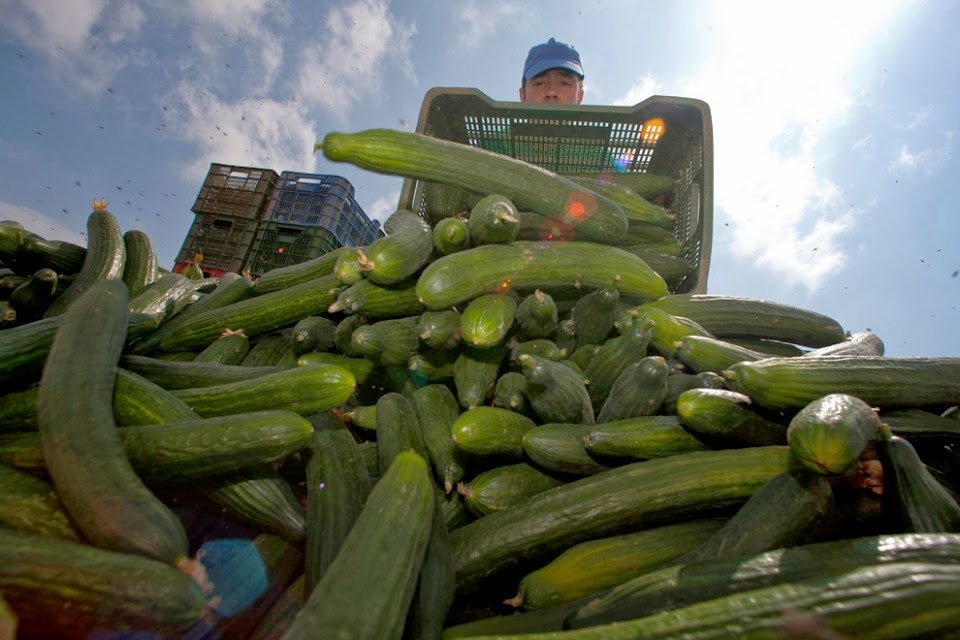 |
| How to grow outdoor cucumbers - http://leckerandyummyrecipes.blogspot.co.uk/ |
Cucumbers are the mainstay of almost every home-made salad the world over. However there is a problem with the modern cucumber. While you can pick up a healthy looking example from most supermarkets at any time of the year but they are typically flavourless and watery. The reason for this is that supermarkets provide guidelines that require cucumbers to be of a particular size, shape, colour and length. If the growers cannot produce a crop to these standards then they risk their cucumbers being rejected at the point of delivery.
And herein lies the problem. There is no mention of flavour or texture within the guidelines and so growers do not need to make no effort to provide a product that has them.
 |
| cucumber crop |
Of course, the very best flavoured and textured cucumbers are those which have been grown in the ground using tried and tested methods established of the centuries, but this creates another problem. The cucumber plant is originally from southern Asia, so to successfully grow it in a northern Europe climate you will need to provide the conditions of is native environment. This means high levels of light and warmth. While cucumbers have been grown in England since the 14th century, it has only been possible to produce a consistently, reliable crop by growing them under protection. This is why they have always been considered to be a greenhouse crop.
However the landscape of cucumber production has changed as specialist plant breeders have been at it for years and developed a range of cucumbers that will produce a viable crop outside without the need for a protected environment.
Outdoor cucumber varieties are known as ridge cucumbers, and as the name suggests they look a little different to shop bought varieties. They tend to be shorter, with a rougher skin and produce male and female flowers which will need to be pollinated. However, as they are grown outside pollinating insects will do all the work for you.
Growing outdoor cucumbers from seed
 |
| cucumber seedling |
If you want to make the most of the shorter, northern European growing season then you will need to sow ridge cucumber seeds in a heated propagator from early March to April. However, if you miss this opportunity to will still be able to bring a crop to fruition if you direct sown outdoors from May to June, but the crop will not be as large.
Cucumber seeds will need to be planted on their sides at a depth of ½ inch 3 inch pots containing a good quality, free-draining, compost such as John Innes 'Seed and Cutting'. Place the pots in a propagator a temperature of 20 degrees Celsius until they germinate. This usually only takes 7-10 days. If you do not have a heated propagator then place the pots into a sealed, clear plastic bag and leave in a warm, bright room out of direct sunlight. Be aware that cucumbers are prone to damage from scorching. Once the seeds have germinated then they can come out of the propagator or be removed from the bag
They can be placed back on to the bright windowsill and grown on until they are large enough to be transplanted. Try to maintain a minimum temperature of 15 degrees Celsius and keep the compost moist but not wet. If the roots become waterlogged then their growth can be retarded, and in extreme cases can result in the death of the plant.
Ridge cucumbers should be gradually acclimated to outdoor conditions over 7-10 days before transplanting into warm, well drained, humus rich soil. Choose a sunny position with shelter from strong winds, and. try to avoid disturbing the roots as much as possible. Planted in to single rows at a distance of 3 ft apart.
Maintenance
 |
| Cucumber harvest |
Unlike greenhouse cucumbers, outdoor cucumbers will not need training onto canes. They are quite happily left sprawling across the ground and show no noticeable drop in cropping.
Pinched out at the main stem after 7 leaves have formed as this will encourage fruiting side shoots to develop.
Harvesting
You can normally begin to harvest cucumbers around 12 weeks from sowing. Using a sharp blade, the best time of the day to cut the fruits from the plant is first thing in the morning. Harvest cucumbers while they are still young and tender. If you harvest when they are older then the fruits can become bitter and full of unpalatable seeds
Regular harvesting will encourage the cucumber plants to continue cropping, and this can continue up until September.
For related articles click onto the following links:
Cucumber 'Long White' Seeds
HOW TO COLLECT AND PREPARE MELON AND CUCUMBER SEEDS FOR PROPAGATION
HOW TO GROW CUCUMBERS
HOW TO GROW GREENHOUSE CUCUMBERS
How to Grow Outdoor Cucumbers
HOW TO SOW AND GROW CUCUMBERS FROM SEED
SALAD CROPS FOR LATE SUMMER/AUTUMN PLANTING
















































